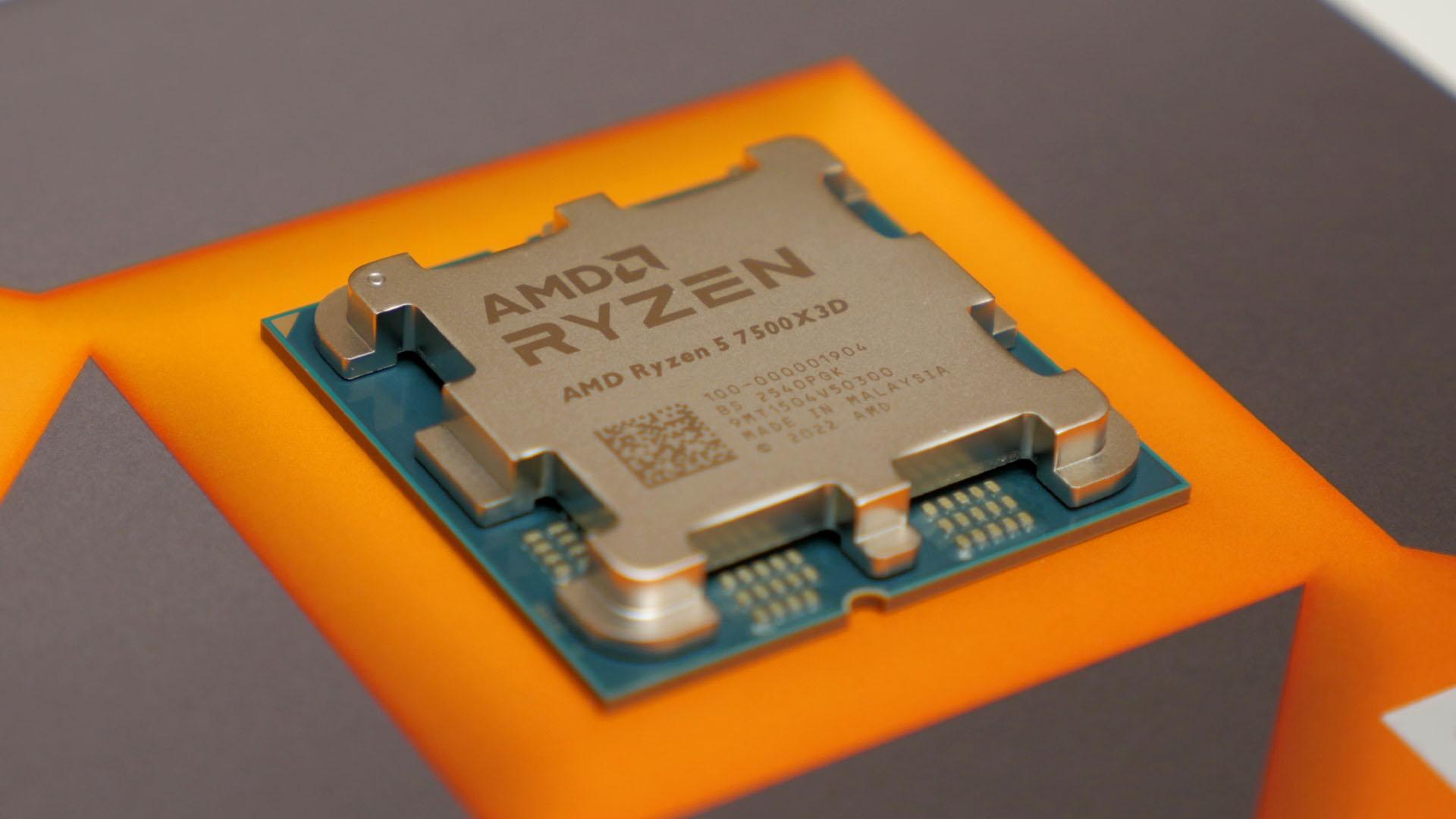-
Новости
- ИССЛЕДОВАТЬ
-
Страницы
-
Статьи пользователей
-
Форумы
New budget AMD Ryzen CPU beats the Intel 14600K by up to 131fps in games, thanks to X3D

New budget AMD Ryzen CPU beats the Intel 14600K by up to 131fps in games, thanks to X3D
The AMD Ryzen 5 7500X3D is official, and it means you can now grab an AMD CPU that includes the company's revolutionary game performance-enhancing 3D V-Cache technology and works on modern AM5 motherboards for its lowest ever price. That means you can build an up-to-date gaming PC using DDR5 RAM that will beat an Intel 14600K system by as much as 111fps in some games.
AMD's X3D processors have consistently topped our best gaming CPU chart since they first arrived with the Ryzen 5800X3D. However, they've always demanded a significant premium over conventional Ryzen CPUs, and while that is still the case with the new Ryzen 5 7500X3D, it marks a new low price point for the range on the AM5 platform.
The key thing here is that while there have been slightly cheaper X3D CPUs before, these have only been for the old AMD AM4 platform. This platform is now two generations out of date, with it still using DDR4 RAM and, while AMD has dropped the occasional new CPU for the platform in the last couple of years, it's effectively a deprecated platform that we wouldn't recommend for building a brand new gaming PC in 2025.
Instead, AMD's AM5 platform is an ideal choice, as it uses DDR5 memory and AMD has committed to using the platform for at least its next-generation Zen 6 CPUs. However, up until the launch of the 7500X3D, the cheapest chip that includes X3D and runs on the AM5 platform was the 7600X3D, which has an MSRP of $299 and which often sells for over $300.
AMD Ryzen 5 7500X3D specs
| AMD Ryzen 5 7500X3D specs | |
| Cores | 6 |
| Threads | 12 |
| Peak boost clock | 4.7GHz |
| Base clock | 4.0GHz |
| L2 cache | 6MB |
| L3 cache | 96MB (32MB on-chip, 64MB 3D V-cache) |
| TDP | 65W |
| Architecture | AMD Zen 4 |
| Socket | AMD Socket AM5 |
| Price | $269 / $244.99 |
The AMD Ryzen 5 7500X3D, then, is almost identical to the 7600X3D, in that it's a six-core chip (able to process 12 threads at once) based on the AMD Zen 4 architecture, but it has slightly slower clock speeds. While the 7600X3D has a base clock of 4.1GHz and a boost clock of up to 4.7GHz, the 7500X3D has a base clock of 4.0GHz and boost clock of 4.5GHz.
As for what the fuss is all about when it comes to X3D, this is AMD's technology that sits an extra chip packed with 64MB of L3 cache (a type of data storage similar to RAM but stored on the CPU) on top of the CPU. This increases the normal amount of L3 cache from 32MB in the Ryzen 7600X to 96MB in the Ryzen 7600X3D, for instance, and means that the CPU has access to a far larger pool of this very fast data cache.
Crucially, because this cache is so much faster than system memory (RAM) that it has huge benefits for performance in certain applications, with one of the most impacted being games. We've seen across our reviews of the 5800X3D, 7800X3D, and 9800X3D, that the advantage X3D provides for gaming is huge, making these the best gaming CPUs of their generation.
With the 7500X3D, it won't be taking any overall gaming performance crown, but it is still a fast CPU for gaming. We're still working on our AMD Ryzen 5 7500X3D review (thanks, failing power supply and motherboard), but AMD's own figures show the 7500X3D consistently outperforming the Intel Core i5 14600K by 11.7% across 10 esports games while maintaining a 7.6% frame rate advantage across 19 AAA games. In PUBG, for instance, the 7500X3D achieves a frame rate of 540fps at 1080p, which compares to just 409fps for the 14600K - an 131fps difference.
The gap's even larger compared to Intel's more recent Intel Core Ultra 7 245KF chip, too. In those esports titles, the 7500X3D is 22% faster, while in AAA titles it's 12.7% faster.
As these are AMD's figures, we can't verify them ourselves just yet, so take them with a grain of salt for now. Particularly as the company hasn't chosen to compare the 7500X3D to the 7600X3D or any other AMD CPUs in its tests, so it's not yet clear just how much performance you're losing with the 7500X3D compared to the 7600X3D. However, with the 14600K being a long-time excellent choice for a mid-range gaming CPU, the 7500X3D consistently outperforming it is impressive.
The other crucial factor to note with this CPU is that it does use the company's slightly older Zen 4 architecture rather than its latest Zen 5 architecture, as used in the 9600X and 9800X3D. This newer architecture brings a touch more overall performance and, crucially, allows for higher clock speeds in its X3D chips than Zen 4.
However, currently there are no cheaper Zen 5 X3D chips than the 9800X3D, so for now the 7500X3D is the cheapest option, at $200 less than the 9800X3D. We'll be back with our AMD Ryzen 5 7500X3D review in the next couple of days to see just whether this new chip truly lives up to its potential.


